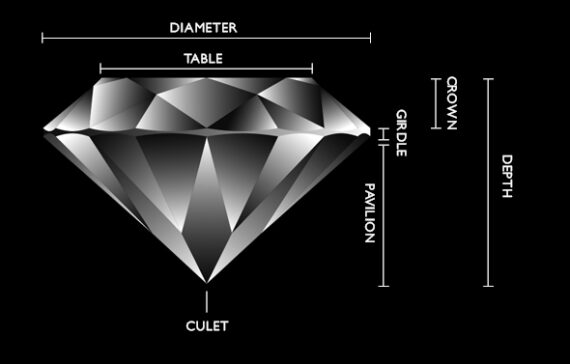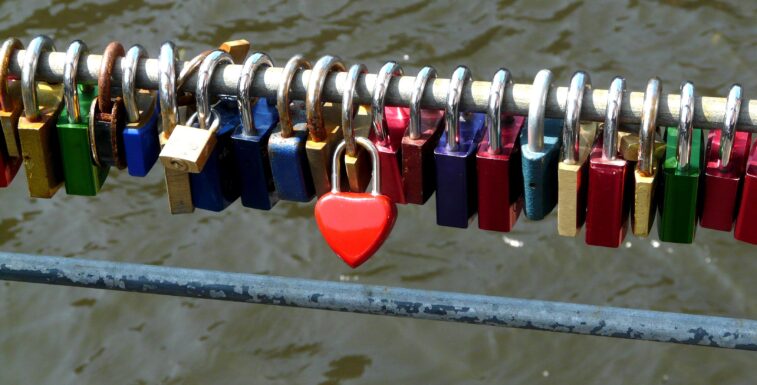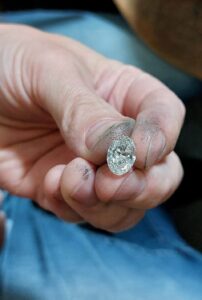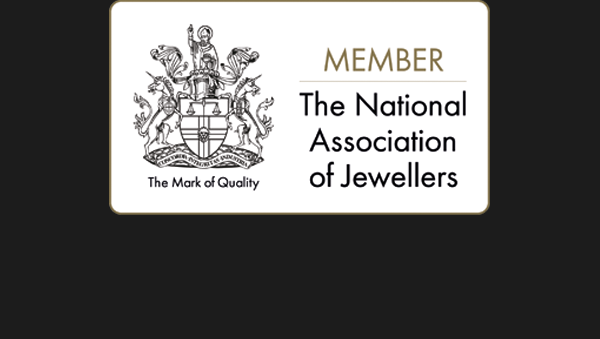KELVINBRIDGE · GLASGOW
|TEL 0141 334 0557
BOOK NOW FOR IN-HOUSE ONE TO ONE OR VIRTUAL/REMOTE CONSULTATIONS
Rules of engagement – selecting the best diamond cut for your bespoke engagement ring
- Date: 11th July 2022
- Author: Blair & Sheridan
- Categories:
Whether you know a little or a lot about diamonds, there is much to consider when selecting the best diamond cut (or shape) of stone to use in your bespoke diamond engagement ring. Most people have heard of the main diamond cuts: Round Brilliant, Princess, Oval, Pear, Marquise, Emerald, Asscher, Cushion, Heart and Radiant. While all diamonds are unique – whether natural or Lab Grown – they all share similar features in the way that they are structured. Read on to learn about the anatomy of a diamond…
The structure of a diamond
There are 7 main components to a diamond; they are: diameter, table, crown, girdle, pavilion, depth and culet.
The ‘diameter’ speaks for itself, its the measurement of the diamond at its widest point. The ‘table’ is simply the top surface of the stone – this is always the largest facet (or surface) of any diamond. If you look at a diamond side on, the ‘crown’ is the section that extends beneath the table. The crown is comprised of a number of facets depending on what cut the diamond is – for example an Oval cut diamond has 33 facets on its crown. The ‘girdle’ is the widest point of a diamond – this is what gives the diamond its overall shape. Typically the ‘pavilion’ is the longest section of a diamond (except in emerald or rectangle shape stones) and this is the part of the stone that reflects the light back up through the crown. Often ‘V’ shaped, the pavilion of a diamond is mostly hidden by the setting. The measured height of a diamond from the table top to the culet is know as the ‘depth’. Finally, the ‘culet’ is the smallest facet of the diamond which sits at the bottom of the stone. The culet should be small to allow light to refract properly – if the culet is to large, it may appear as a shadowy mark or a hole. If the pavilion comes to a complete point, there will be no culet.
Which is the right cut for me?
While of course entirely down to personal preference, at Blair and Sheridan we can help guide you to the right diamond cut for your individual ring design. Round brilliant cut and Princess cut diamonds lend themselves well to solitaire ring designs with various stone setting options offering endless finishes and styles. A Marquise cut diamond pairs well with Baguette or Trilliant cut stones on either side to form a beautiful trilogy ring. The geometric lines of Emerald and Asscher cut diamonds are associated with art deco, vintage/antique style designs. The journey of your bespoke engagement ring begins with a personalised one-to-one consultation where our experienced designers will explain the entire process. Working to your spending limit and incorporating your personal touches and ideas, we will explore diamond cuts together along with precious metal types and settings. You will have the opportunity to hand select your diamond making your experience with Blair and Sheridan entirely unique.
A-list diamonds and star studded proposals
Going by recent ‘high-profile’ engagements over the last few years, it is fair to say the Emerald and Oval cut diamonds are enjoying their time in the limelight. Jennifer Lopez accepted Ben Affleck’s proposal in April 2022 with a whopping 8.5 carat Emerald cut green diamond ring (J-Lo’s 6th engagement ring to date!). Emerald cut diamond solitaires are also adorned by Amal Clooney and Beyonce who wear 7 carat and 24 carat showstoppers respectively. Delicate bands and large Oval cut diamonds have been the style staple of Hailey Bieber, Arianna Grande and Blake Lively whose engagement rings all share Oval stones ranging from a modest (!) 5 carat to 12 carat weight. While a 24ct diamond is out of reach for most people, your bespoke engagement ring will be entirely individual and unique to you regardless of the size of diamond you opt for. We can advise on the best setting to maximise the size of your chosen diamond and show it off with maximum effect and sparkle. It’s also worth considering Lab Grown diamonds as they are more favourably priced than their traditional natural diamond counterpart.
(Above) A soft V-shape 4 Claw Set diamond solitaire with a 4.01ct Oval cut diamond, gradually tapered shoulder detail
Diamond terms
There is an endless terminology of words which are used to describe the various characteristics of diamonds. At Blair and Sheridan we are fully trained in diamond grading and can explain everything you need to know to assist with your diamond choice and ring design. Many people have heard of the 4 ‘C’s:
1. Cut – this is simply the shape (Round, Princess Baguette etc)
2. Colour – the ‘best’ grading for a colourless diamond is D, the scale goes from D (icy white colourless) to Z (with a yellow hue)
3. Clarity – this refers to the markings (or flaws) in the stone, the ranges goes from ‘flawless’ to ‘included 3’
4. Carat – 1 carat is divided into 100 points, so a 50 point diamond is equal to 0.50 carats
Other notable terms to be aware of:
Lab Grown Diamond – these are diamonds which are formed under laboratory conditions as opposed to naturally formed diamonds, both natural and Lab Grown diamonds are chemically and visually the same – read more about Lab Grown diamonds here
Brilliance – this term refers to the diamond’s ability to reflect white light, which in turn optimises sparkle and brightness
Fire – refers to the diamond’s ability to reflect coloured light – the coloured flashes of light you see when your diamond is directly under a light source
Scintillation – this is how well the diamond reflects light when it is moving
Polish – the polish is the quality of the facet surfaces of the diamond, this affects the ability of a stone to absorb, refract, and reflect light
Facets – these are flat surfaces on a diamond, the number of facets depends on the cut (or shape of the stone)
While not exhaustive, this guide gives you an insight to diamond and stone selection. If you are considering proposing our friendly knowledgeable staff at Blair and Sheridan we will guide you every step of the way. Get in touch to find out more.
CATEGORIES
Archives
- November 2024
- August 2024
- June 2024
- May 2024
- March 2024
- February 2024
- January 2024
- December 2023
- November 2023
- August 2023
- June 2023
- April 2023
- February 2023
- December 2022
- August 2022
- July 2022
- May 2022
- April 2022
- January 2022
- November 2021
- September 2021
- June 2021
- April 2021
- November 2020
- August 2020
- April 2020
- March 2020
- February 2020
- January 2020
- May 2019
- March 2019
- October 2018
- May 2017
- April 2017
- March 2017
- February 2017
- January 2017
- March 2016
- October 2015
- June 2015
- May 2015
- April 2015
- March 2015
- February 2015
Recent Posts
- Crystal clear, keeping the sparkle in your bespoke jewellery
- Blair and Sheridan ongoing support of Maggie’s Glasgow Charity
- The world is your oyster… it’s up to you to find the pearls
- Diamonds are forever – picking the right cut and style for your bespoke jewellery design
- Bespoke hinged rings – unique craftsmanship by Blair and Sheridan
CONTACT US
- Blair and Sheridan
- Bespoke Diamond Jewellers Glasgow
- 417 Great Western Road
- Kelvinbridge
- Glasgow G4 9JA
- T: 0141 334 0557
- E: info@blairandsheridan.co.uk
RECENT NEWS
- Crystal clear, keeping the sparkle in your bespoke jewellery 6th November 2024
- Blair and Sheridan ongoing support of Maggie’s Glasgow Charity 12th August 2024
COPYRIGHT © 2018 BLAIR AND SHERIDAN | BESPOKE DIAMOND JEWELLERS GLASGOW, SCOTLAND SC 412681 VAT No. GB 131 6499 13 | Terms & Conditions | Privacy Policy | Contact Us




